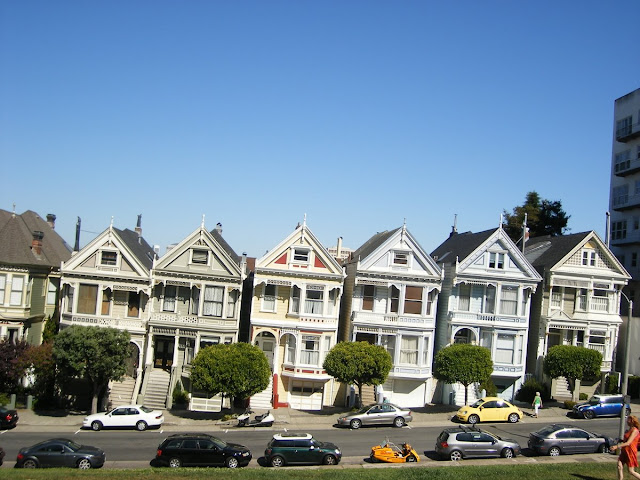
Text information was taken from Wikipedia, the free encyclopedia
Photo credits by *PIZZICATTO*
 San Francisco Painted Lady is a term used for Victorian and Edwardian houses and buildings painted in three or more colors that embellish or enhance their architectural details. The term was first used for San Francisco Victorian houses by writers Elizabeth Pomada and Michael
San Francisco Painted Lady is a term used for Victorian and Edwardian houses and buildings painted in three or more colors that embellish or enhance their architectural details. The term was first used for San Francisco Victorian houses by writers Elizabeth Pomada and Michael  Larsen in their 1978 book Painted Ladies - San Francisco's Resplendent Victorians. Since then the term has also been used to describe groups of colorful Victorian houses in other American cities, such as the Charles Village neighborhood in Baltimore City, Lafayette Square in St. Louis, the greater San Francisco and New Orleans areas, Columbia-Tusculum in Cincinnati and the city of Cape May, New Jersey. Some preservationists use the term polychrome for the style.
Larsen in their 1978 book Painted Ladies - San Francisco's Resplendent Victorians. Since then the term has also been used to describe groups of colorful Victorian houses in other American cities, such as the Charles Village neighborhood in Baltimore City, Lafayette Square in St. Louis, the greater San Francisco and New Orleans areas, Columbia-Tusculum in Cincinnati and the city of Cape May, New Jersey. Some preservationists use the term polychrome for the style.
About 48,000 houses in the Victorian and Edwardian styles were built in San Francisco between 1849 and 1915 (with the change from Victorian to Edwardian occurring on the death of Queen Victoria in 1901), and many were painted in bright colors. As one newspaper critic noted in 1885, "...red, yellow, chocolate, orange, everything that is loud is in fashion...if the upper stories are not of red or blue... they are painted up into uncouth panels of yellow and brown... While many of the mansions of Nob Hill were destroyed by the 1906 San Francisco Earthquake, thousands of the mass-produced, more modest houses survived in the western and southern neighborhoods of the city.
Painted Ladies in the Haight Ashbury, San Francisco, CaliforniaDuring World War I and World War II, many of these houses were battleship gray with war-surplus Navy paint. Another sixteen thousand were demolished, and many others had the Victorian decor stripped off or covered with tarpaper, brick, stucco, or aluminum siding.
In 1963, San Francisco artist Butch Kardum began combining intense blues and greens on the exterior of his Italianate-style Victorian House. His house was criticized by some, but other neighbors began to copy the bright colors on their own houses. Kardum became a color designer, and he and other artists such as Tony Cataletich, Bob Buckter, and Jazon Wonders began to transform dozens of gray houses into Painted Ladies. By the 1970s, the colorist movement, as it was called, had changed entire streets and neighborhoods. This process continues as of 2007.
One of the best known groups of "Painted Lady" is the row of Victorian houses at 712–720 Steiner St., bordering Alamo Square park, in San Francisco. This block appears very frequently in media and mass-market photographs of the city and its tourist attractions. It is sometimes known as "Postcard Row." The houses were built between 1892 and 1896 by developer Matthew Kavanaugh, who lived next door in the 1892 mansion at 722 Steiner St. These houses also appear in the opening credits of the television series Full House.

No comments:
Post a Comment
Comment: